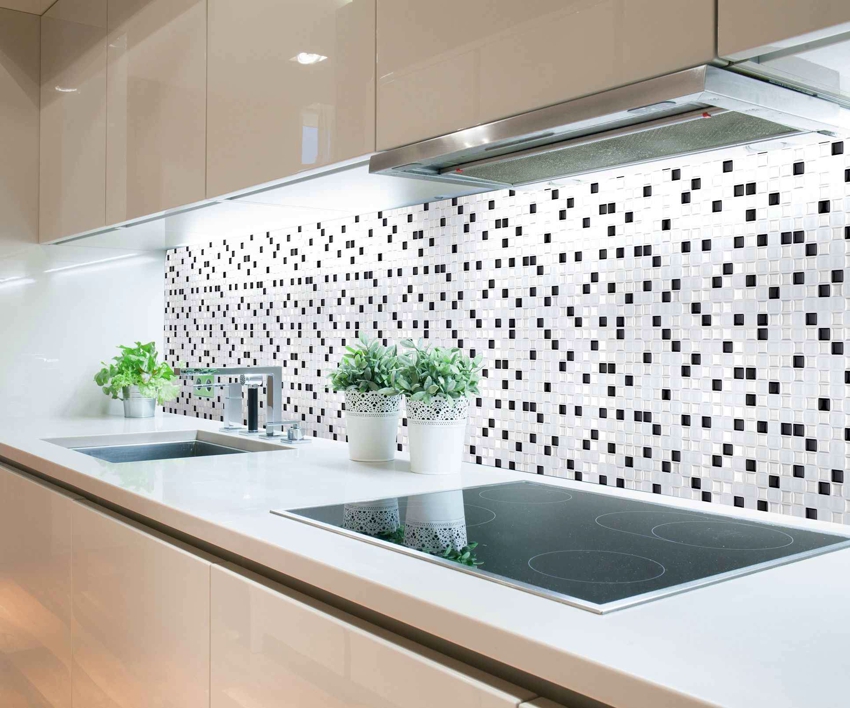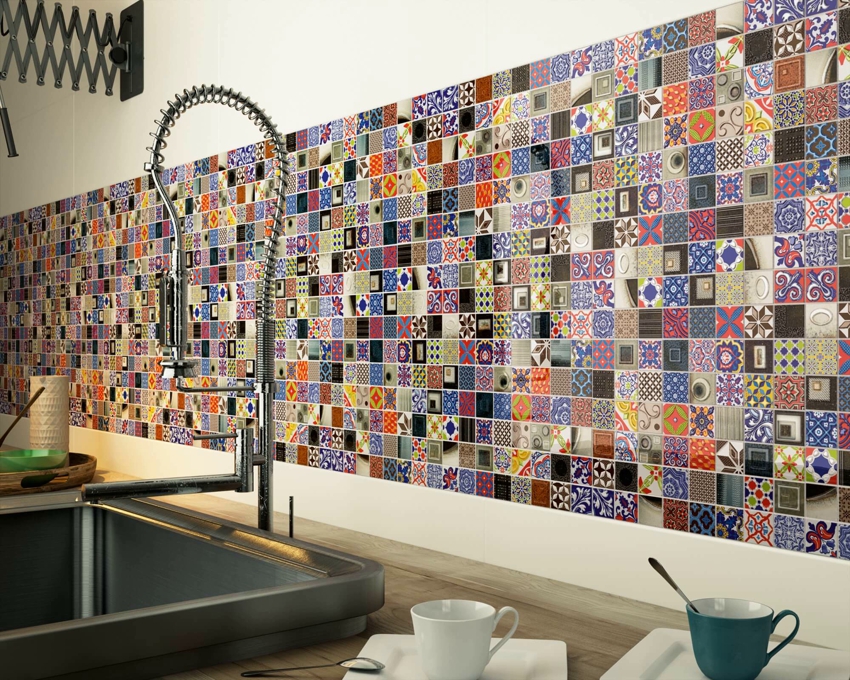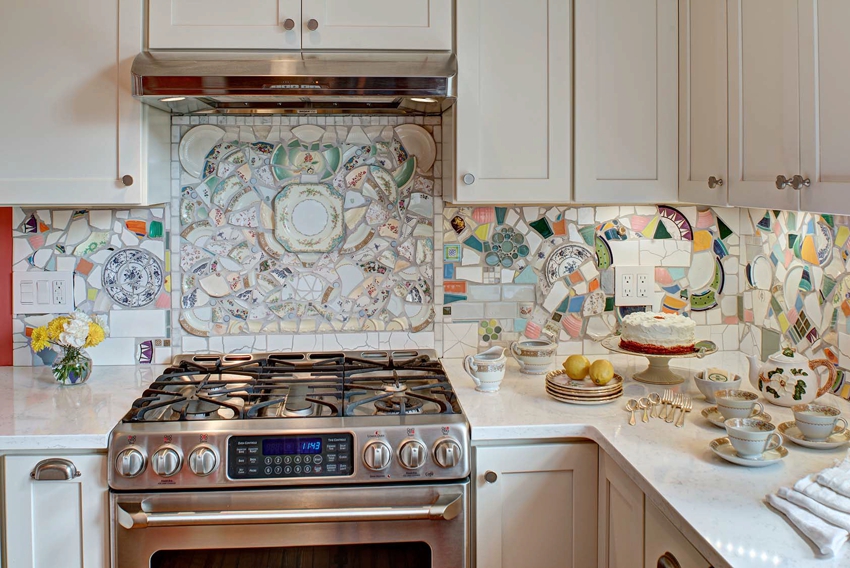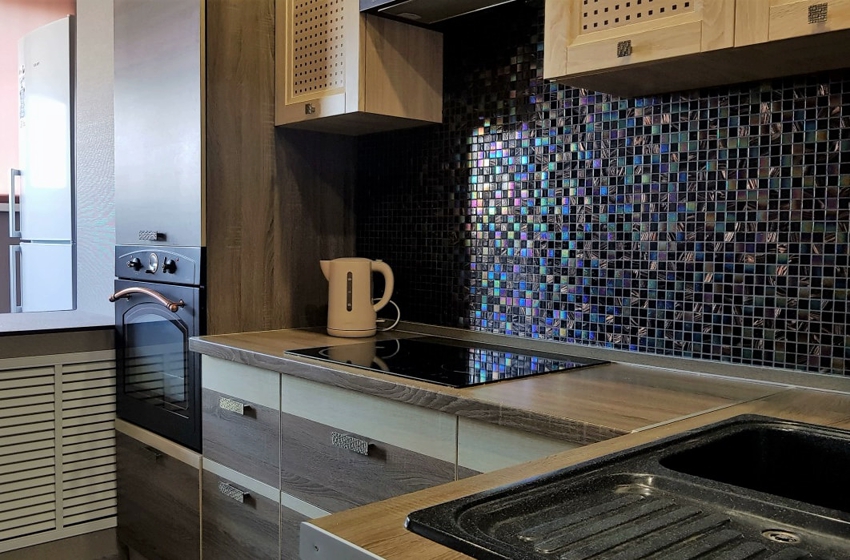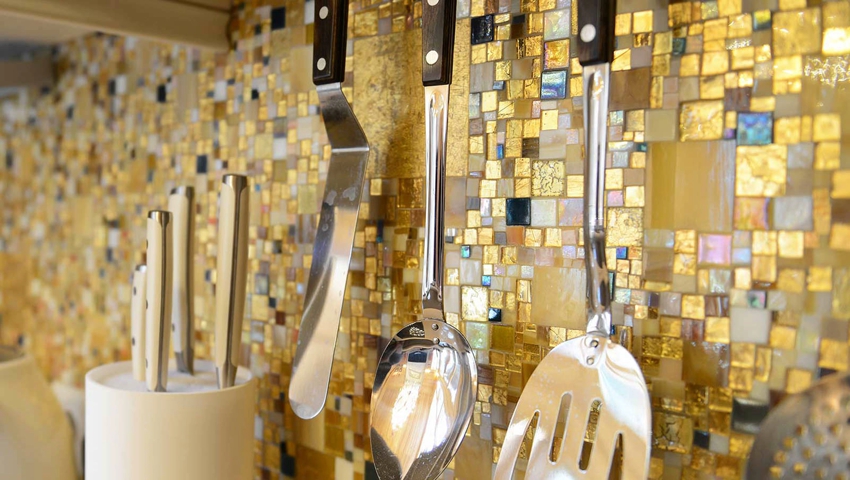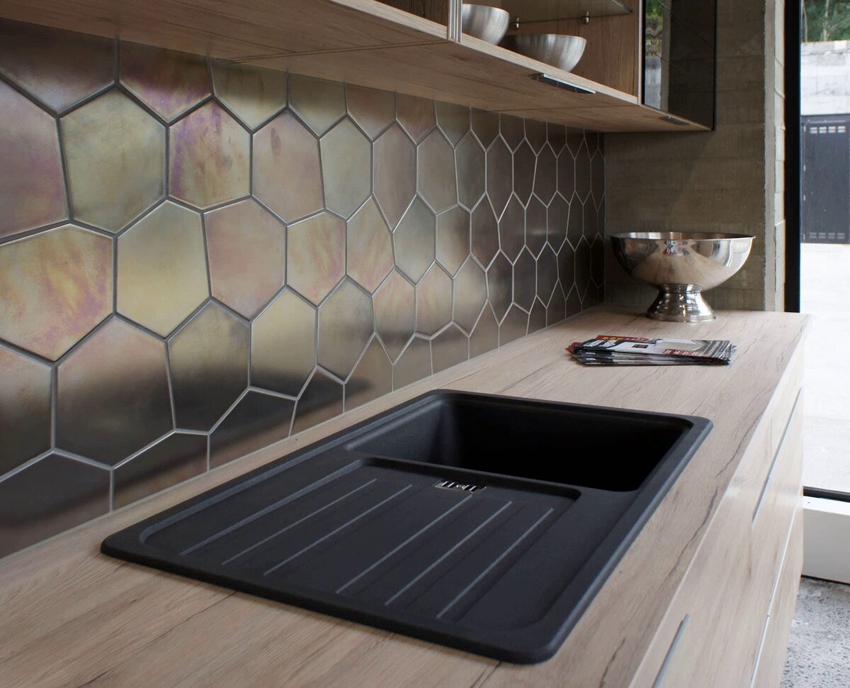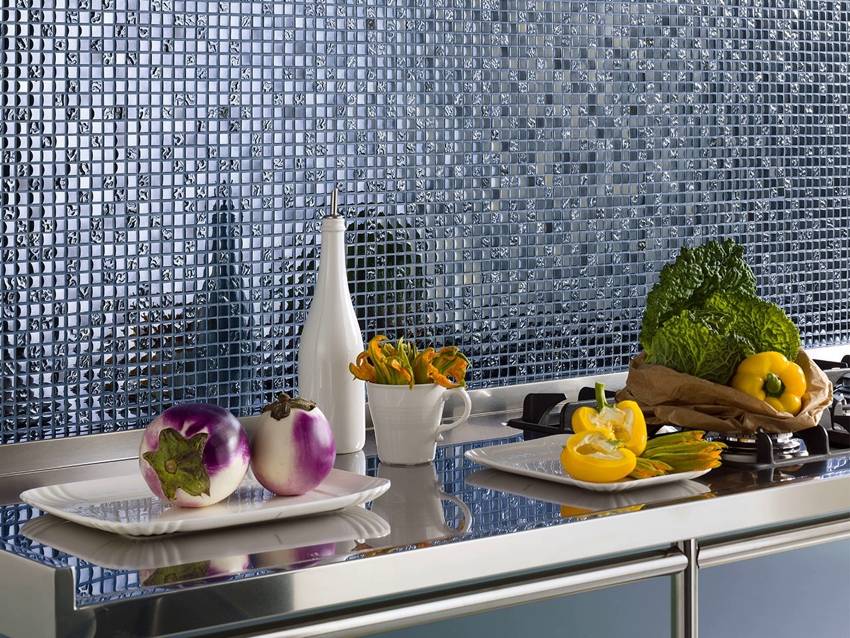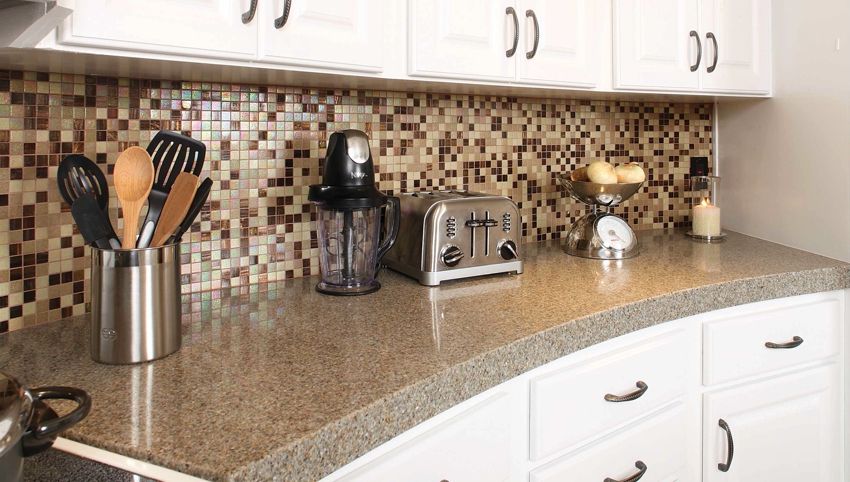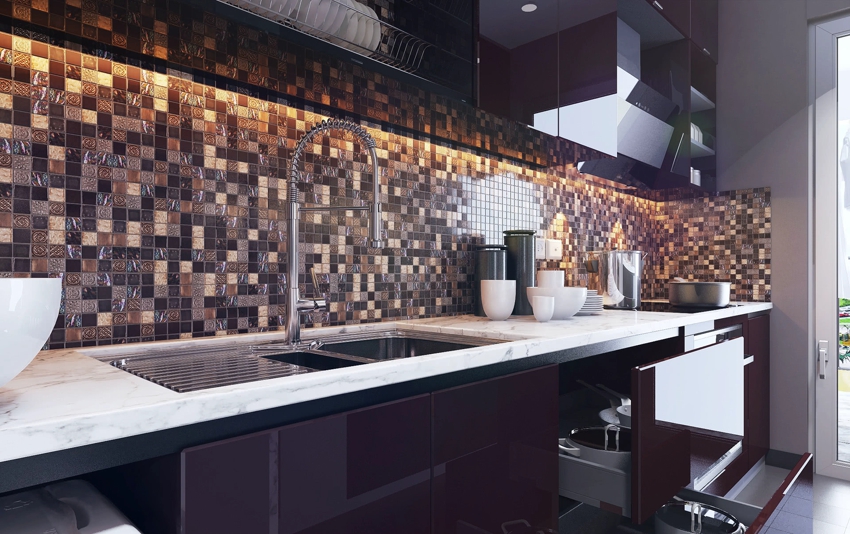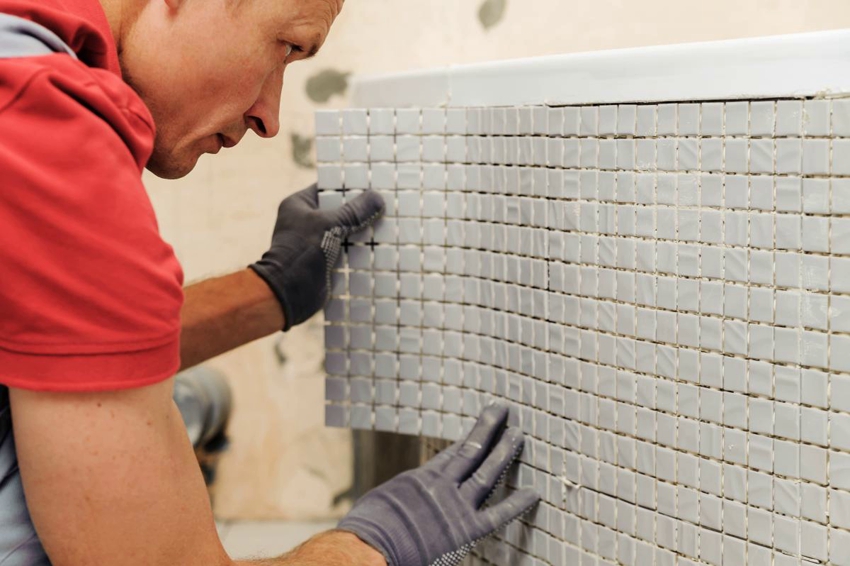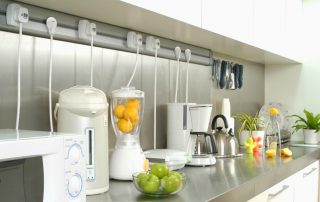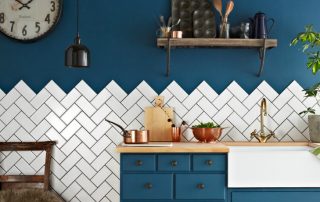The main task of the kitchen backsplash is to protect the walls from dirt, which cannot be avoided during cooking. Moreover, it should be not only practical, but also attractive, combined with the overall design of the room. Therefore, this part of the interior should be given special attention. A popular type of decoration is mosaic tiles for the kitchen on the apron. How to choose the right one, pick up the material and stick the mosaic yourself - this article will tell you.
Content [Hide]
- 1 Mosaic apron in the kitchen: application features
- 2 Stylish solution of a mosaic apron for the kitchen
- 3 Mosaic tiles for the kitchen on the apron: material features
- 4 The shape and size of the mosaic tile for the kitchen on the apron
- 5 What materials will be needed for laying mosaic tiles
- 6 Laying mosaics on the walls with your own hands
Mosaic apron in the kitchen: application features
Mosaic tiles for the kitchen are a non-trivial alternative to traditional aprons made of large-format tiles, which have been proven by many years of experience by thousands of housewives. It will compete even with fashionable novelties such as porcelain stoneware, decorative stone or glass. Basically, mosaic tiles are made from similar materials, but their appearance and quality have their own characteristics.
Mosaic in the interior design appeared a long time ago, long before the concept of "interior design" appeared. People began to lay out abstractions on the walls of houses and the faces of saints in churches using multi-colored stones more than a thousand years ago. The floor in palaces and garden paths were ennobled in the same way.
First of all, you should pay attention to the fact that it is quite difficult to lay such tiles on the wall, especially if the repair is done by hand. Yes, and an experienced master before work must carefully prepare the surface, leveling it to an ideal state, and aligning the positions so that the drawing does not distort. When purchasing material, it should be borne in mind that mosaics in separate cubes are a rarity. Basically, this type of decorative finish is sold as mosaic sheets on a paper or mesh backing. If the tile is located on paper, then it is laid in such a way that the base can be removed. If there is a grid at the base, then the mosaic is attached to the wall with the grid base.
Useful advice! Before laying the mosaic, the wall must be leveled.If the initial surface is strongly curved, then in order to make it even, it is better not to apply many layers, but to use plasterboard cladding.
It should be noted that much more consumables such as glue and grout are required than with conventional large-format ceramic tiles. Finishing also involves a large number of seams, therefore, in order to protect the surface from the negative effects of moisture, it is necessary to use exclusively epoxy grout. And such material is expensive. Therefore, before gluing the mosaic tile, you should weigh your financial capabilities.
Advantages and disadvantages of a mosaic apron for the kitchen
Any interior design has its pros and cons, a mosaic apron in the kitchen is no exception. This type of design solution in the modern world is experiencing its rebirth, since half a century ago, mosaic was quite popular. This is due to a number of advantages, in particular:
- durability of the material. For the manufacture of mosaics, expensive and high-strength materials are used, which are quite difficult to damage. Small size does not allow physical damage, temperature drops are also safe for mosaics;
- ease of care. Certain types of mosaic tiles can be safely cleaned even with abrasive materials. In this case, the surface will remain intact. Subject to the correct selection of grout, the work surface will be invulnerable to moisture and acids;
- a mosaic kitchen apron is also a stylish design element. A mosaic wall can become a missing accent in a room that was just missing.
This interior solution also has disadvantages:
- high material cost. A high-quality mosaic is quite expensive, so saving money here is problematic, but possible. If you follow the sales, then you can choose a budget option;
- the complexity of the installation work. Installing a simple tile requires certain skills, and mosaics are even more difficult. The features of the small structure will help to hide some of the shortcomings, however, if an ideal result is required, then it is better to entrust the work to professionals;
- complexity in styling. A small and variegated pattern on the wall will not fit into every style, which must be taken into account when choosing a material for a working wall in a kitchen.
Stylish solution of a mosaic apron for the kitchen
In Soviet times, mosaic walls adorned the premises of shops, hospitals, childcare facilities, train stations and metro stations. Many illustrative examples in the form of portraits and subject paintings in such objects have survived to this day. Gradually, the mosaic returned to the design of housing, in particular, to the interior of the kitchen. Subject to the correct choice of shape, texture, color and motive, it can harmoniously fit into both the Art Nouveau style and Provence and even boho.
Those who prefer the classic style should pay attention to the plain ceramic mosaic. In this case, the tiles should not be too small, but also not very large. It is better to match the color of the working wall to match the rest of the walls or to match the kitchen set. An additional dull color of the apron, which is present in other decorative elements, will also be appropriate in the design of a classic kitchen.
Important! Today, the design of the kitchen interior in a single color is in fashion. Therefore, a safe option in any style would be mosaic tiles to match the main wallpaper or furniture.
For Provence, a mosaic apron in a kitchen made of ceramics in delicate colors is perfect. For country, it is better to use natural or artificial stone, which is practical and durable.The texture of this material is already attractive in itself, so it is great for decorating "rustic" kitchens.
Fans of minimalism should pay attention to the monochrome color scheme. White, black or gray tiles with inserts of glass or mirror tiles, which will create the necessary accent, will fit best. A similar design of the apron is also suitable for the Art Nouveau style. Design in ethno and boho styles assumes bright shades, variegation and eclecticism, which should also be present on the working wall. A bright mosaic tile pattern in the kitchen will be appropriate here.
How to choose the right color for your kitchen mosaic tile
The color combination is an important element in the design of the working wall in the kitchen. Most often, it matches the basic tone of other walls or echoes in color and texture with the countertop, but it can also become an irreplaceable accent in the interior.
The mosaic has a variety of colors and can be:
- monogamous, that is, all tiles in the matrix are the same in size and color;
- the color mix is presented in the form of modules that include different colors within a certain color gamut or scheme, a chaotic arrangement of bright accents is allowed;
- the gradient is most often used in the design of bathrooms, since it has the shape of rectangular matrices with a smooth transition from light to dark, in the kitchen it is appropriate if it is placed from right to left, and not from top to bottom.
- a panel is a ready-made pattern that is simply placed on an apron, while combining with a monochromatic mosaic, which is in harmony with the color of the pattern on the panel.
Particular attention in choosing the color scheme of the walls in the kitchen should be paid to white. An apron for a light kitchen should not be very different, but be in tune with the furniture, besides, on a white panel and color accents look much more profitable. An apron made of white mother-of-pearl mosaic looks especially elegant. Due to the small shape and the change in texture, a slight shimmer is created on the surface, in detail to the mirror. Mirror mosaic in the interior will help visually expand the room. It is not necessary that the entire work surface is made of mirrors; it is enough to combine it with matte tiles.
Useful advice! For grouting mosaic tiles, regardless of their shape, color and size, it is best to choose gray and white. Materials to match the mosaic are also acceptable, but you should be careful with contrasting tones so as not to create excessive diversity in the kitchen.
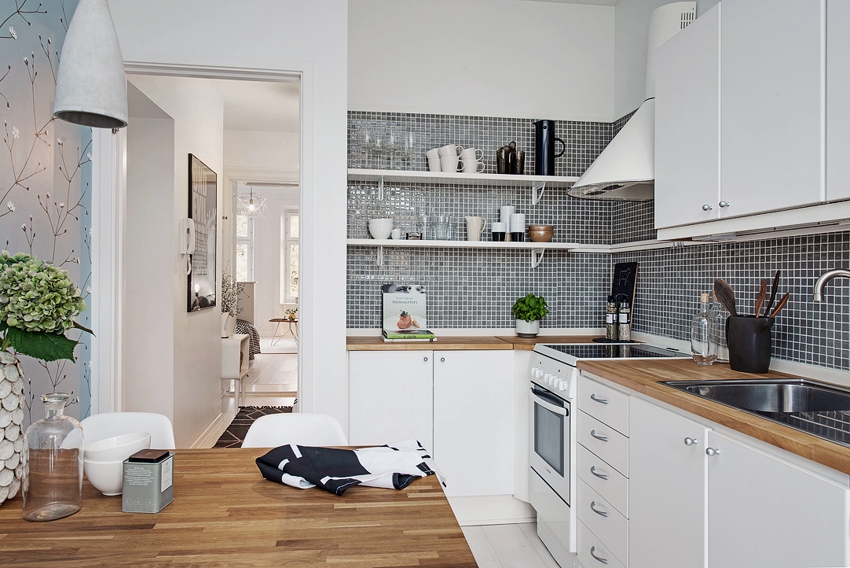
The color of the finishing of the work area does not have to match the shade of the furniture and countertop
Mosaic tiles for the kitchen on the apron: material features
Mosaic tiles are made from a variety of materials: from plastics to stone. The price of mosaic tiles largely depends on this. The most popular is ceramics. Its main advantages are durability, a wide choice of colors and different styles of design. With the help of ceramic tiles, you can create any surface, both glossy and matte, smooth or rough.
Glass is also considered an affordable material in terms of price, but it is more practical and more durable due to the high temperature firing used in the production of glass for tiles. In a monochrome kitchen, glass mosaic tiles are a great accent, creating a play of color through the refraction of light. Most often, glass mosaics are produced on a grid, and the surface coating can be very diverse: glossy, transparent, matte, interspersed with glitter or metal.
Glass tiles are conventionally divided into the following types:
- Homogeneous glass mosaics are small glass blocks with a glossy or matte surface. Multi-colored and multi-textured blotches are possible.
- Smalt is a mixture of colored glass created by pressing with metal oxides.Such material is much stronger than glass, so the tiles from it are laid even on the floor. Differs in rich color and various effects depending on the additives.
- Glass tiles with added minerals. They even produce mosaics from glass that imitate precious stones. For this purpose, aventurine or iridium is added to the glass melt. Such tiles are very expensive, but they have a unique shimmering or iridescent surface.
Stone and metal mosaic on the walls: advantages and disadvantages
Natural stone is out of competition when it comes to kitchen tiles. Such a mosaic will last forever, giving the interior charm and solidity. It is best to opt for marble or granite. These stones, due to their porosity, do not absorb odors, but at the same time they are unstable to paints, therefore they are treated with special impregnations.
Porcelain stoneware is an excellent alternative to both ceramics and stone. The material is as strong as stone, but less porous and more affordable, like ceramics. Loses in design variations - due to the lack of a glossy surface and limited choice of colors. Only options in the range from beige to dark brown are possible.
Useful advice! For a small kitchen, in order to avoid variegation, it is best to take small tiles of the same color. In spacious rooms, experiments with both color and size are permissible.
A rare option is a metal mosaic. This tile is used as an addition. They are made from rubber or ceramics, covered with a layer of stainless steel, brass or bronze. Metal tiles are not durable, but they look amazing.
The shape and size of the mosaic tile for the kitchen on the apron
When choosing a tile by shape, you should take into account the structure of the pieces, and not the pattern that will be made up of the mosaic. The most common option is mosaic squares, but there are also round, oval, diamond and even trapezoidal tiles. The unusual shape creates its own unique visual effect, but it is also much more difficult to lay it than the usual squares or rectangles. Therefore, the most popular is the square mosaic, presented on sale in the form of "matrices" with parameters of 30x30 cm. The number of tiles in the matrix can be different, depending on the size of the mosaic and the manufacturer.
The main feature of the mosaic is its small size. Large tiles can be found in panels or in non-standard mosaic compositions. For example, a honeycomb mosaic is produced much larger than standard squares. The rectangles resembling bricks are also larger.
In order to determine the required mosaic size, it is necessary to measure the apron and choose the most profitable option. On sale you can find loose products, but most often these are matrix blanks of different sizes. The smallest is 24x24 cm, the largest 32x32 cm, but there are also intermediate options, for example 28x28 and even 31.5x31.5 cm. As a rule, 9 matrices fit into 1 m².
The small fragments in the matrix are called chips. Their size varies from 1x1 to 10x10 cm. The most popular models for kitchen cladding are 2x2 or 5x5 cm chips. It is best to purchase matrices on a grid, such a base does not tear, and it is much easier to glue it. In addition, the mesh has a reinforcing function.
What materials will be needed for laying mosaic tiles
An important step in choosing a finish for a kitchen is the selection of consumables. Before gluing the mosaic to the walls, you will need to purchase materials such as glue and grout. You can do without glue only in one case, if you use a self-adhesive decorative mosaic.The main qualities of the adhesive mixture for tiling a kitchen apron with mosaics are strength and water resistance. It should also contain anti-fungal components. Therefore, before you start laying, you need to figure out not only what to glue, but also what to glue the mosaic on.
Related article:
Cupboard for kitchen: types and functional features
Forms, sizes. Features and differences of mounted and floor models. Alternative design options for dish storage systems.
Grout is an equally important consumable. It is available in two versions: cement based or epoxy based. The first type of grout is much easier to apply and spread over the surface, so it is much more acceptable when it comes to self-installation. In addition, such material costs much less.
Useful advice! If preference is given in favor of white seams, then it is best to purchase a mixture based on epoxy resin. At the same time, it is rather difficult to independently perform work with such material, so it is better to entrust it to professionals.
Before gluing the mosaic to the wall, it should be borne in mind that the cement grout is more vulnerable to frequent washing, moreover, it is soaked much faster with various kitchen dirt, and therefore it darkens much faster and the entire mosaic apron loses its original appearance.
The grout for mosaic tiles, which is based on epoxy resin, is considered by experts to be of better quality in terms of adhesion and performance. The material is moisture resistant, therefore it practically does not absorb moisture, in addition, it is practically not afraid of dirt. Seams filled with epoxy can be safely cleaned using any household chemicals without fear that the material will change color. The main disadvantage of epoxy grout is the high cost of the material, as well as the difficulty in using it, which only an experienced craftsman can do.
How to choose glue and grout for glass mosaic tile
The universal color for grouting is considered to be white or light gray. Coloring to match the apron itself or contrasting shades is also allowed. At the same time, a glass mosaic kitchen apron has its own characteristics. It is also necessary to consider what the glass mosaic is glued to. The adhesive for such tiles should be exclusively white.
The choice of grout for glass mosaic also has its own nuances. Glass tiles are semi-transparent or completely transparent, so any imperfections associated with consumables will be visible here. Even through matte tiles, imperfections will be visible. A light gray epoxy grout is best suited for this. This rule also applies to colored glass tiles.
It is also important to pay attention to such a factor as adhesion to the surface. Glass tiles, unlike ceramic tiles, have no pores, so they are less firmly attached. To ensure reliability, you should take special adhesives and grouts with a high level of adhesion. Their indicator should be at least 20 kg per 1 cm² of surface.
Laying mosaics on the walls with your own hands
Before gluing the mosaic tile to the wall, you need to prepare the materials. Purchase tiles, glue and grout. If you plan to work independently, then it is better to take a cement-based grout, and not epoxy resin. If we are talking about an expensive mosaic, then it is better to entrust the work of its installation to professionals.
Useful advice! If you plan to lay a multi-colored mosaic, then you must adhere to the rule that you should not use more than three colors in the interior design.
The preparatory work includes several stages:
- preparation of the base.The wall under the future mosaic kitchen apron must be carefully leveled, cleaned of dirt, and dried. Wait at least 10 days after filler before laying. In this case, it is necessary to use only white putty;
- wall markings. In order for the seams to be the same, and the apron itself looks neat, before gluing the mosaic on a grid or on a paper base, it must be laid out on the floor so that the intervals between the tiles are equal to the size of the seams. After that, the layout in the same sequence is carefully applied to the wall, marking the dimensions of the chips and seams. The ease and pace of work depends on the accuracy of the marking;
- preparation of glue. The glue is diluted in accordance with the instructions. It is better to use a drill with a special mixer attachment and knead the solution until it becomes thick sour cream. It is better not to use the entire dry mixture at once, since the glue dries out rather quickly, and you cannot re-add water.
How to glue mosaic tiles on the wall
Before gluing the mosaic to the apron, you need to prepare two spatulas. First, the glue solution is applied to the wall with a smooth spatula, and after that it is leveled with a special spatula with square teeth measuring 3x3 cm.Then, the tiles are laid out in accordance with the markings, fixing each chip by tapping on it with a rubber spatula.
During installation, do not press hard on the tiles so that the glue does not seep from the seams. This can also happen if the wall is uneven. The most convenient in the process of laying ceramic mosaic on a grid. This type of tile does not require preliminary marking, and the seams are smooth and identical.
The adhesive under the tiles dries in about three hours. After that, carefully remove the paper or film. The paper base will be easier to remove if you moisten it with warm water beforehand. After that, you can start rubbing the seams. The mixture is applied with a rubber spatula, while slightly pressing and evenly distributed over the mosaic, both vertically and horizontally.
After that, the excess is removed. After about an hour, when the grout has not yet dried, but has begun to harden, its remains are removed with a damp sponge. This must be done carefully so as not to wash it out of the seams. If the grout has had time to adhere well, then it can be removed with an alkaline solution.
There are many options for decorating the work wall in the kitchen. Mosaic tiles look especially original in the interior. At the same time, when choosing a finish, it is necessary to focus on the material from which the mosaic is made, as well as on the conformity of the glue and grout. If you follow the described recommendations, you will end up with an exquisite and at the same time practical kitchen apron.

